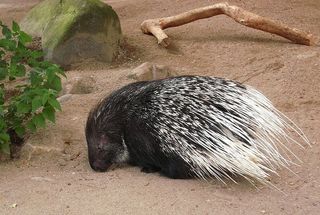
North African crested porcupine
Order : Rodentia
Suborder : Hystricognathi
Family : Hystricidae
Species : Hystrix cristata
The Crested porcupine, north african crested porcupine is listed as Least Concern. Does not qualify for a more at risk category. Widespread and abundant taxa are included in this category, on the IUCN Red List of Threatened Species
Namings for the North African crested porcupine
A young / baby of a North African crested porcupine is called a 'pup'. The females are called 'sow' and males 'boar'. A North African crested porcupine group is called a 'prickle or family'.Countries
Algeria, Benin, Burkina Faso, Cameroon, Congo, Democratic Republic of the, Egypt, Eritrea, Ethiopia, Gambia, The, Ghana, Greece, GuineaBissau, Italy, Kenya, Liberia, Libya, Mali, Mauritania, Morocco, Niger, Nigeria, Senegal, Sierra Leone, Somalia, Sudan, Tanzania, Togo, Tunisia and UgandaNorth African crested porcupine habitats
Arable Land, Artificial / Terrestrial, Dry savanna, Grassland, Mediterranean-type Shrubby Vegetation, Savanna, Shrubland, Subtropical / Tropical Dry Grassland and Subtropical / Tropical Dry ShrublandSome facts about the
African porcupine
Adult weight : 20 kg (44 lbs)
Maximum longevity : 28 years
Gestation : 66 days
Litter size : 2
Litters per year : 2
Weight at birth : 1 kg (2.2 lbs)
Facts about the North African crested porcupine
Class: Mammalia PHYSICAL CHARACTERISTICS: The North African crested porcupine is the largest porcupine on earth.
The European Porcupine (Hystrix cristata) is the typical representative of a family of Old World rodents, the Hystricidae, all the members of which have the same protective covering.
The European Porcupine (Hystrix cristata) is the typical representative of a family of Old World (Full text)
"The North African crested porcupine is the largest porcupine on earth". (Full text)
More animals beginning with N
